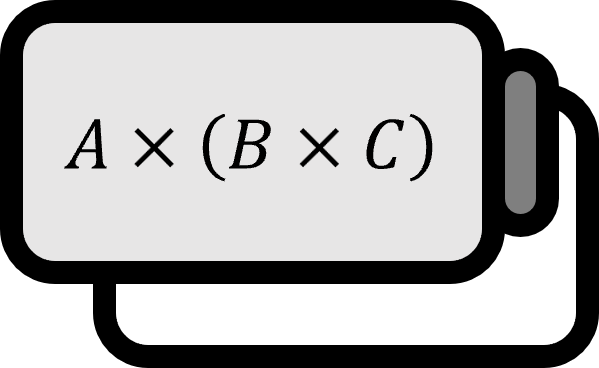Kronecker Delta
Definition
We define $\delta_{ij}$ as the Kronecker delta.
$$ \delta_{ij} := \begin{cases} 1,&i=j \\ 0, & i\ne j \end{cases} $$
Explanation
The Kronecker delta is used in many places, primarily to highlight the desired components (elements, possibilities, etc.) among all possible options. Physics students often encounter it in the context of dot products. If this concept isn’t immediately clear, consider the following example:
Example
Suppose we are given two vectors $\mathbf{A}=(A_{1}, A_{2}, A_{3})$ and $\mathbf{B}=(B_{1}, B_{2}, B_{3})$. The dot product of these vectors is given as follows:
$$ \mathbf{A} \cdot \mathbf{B} = A_{1}B_{1} + A_{2}B_{2} + A_{3}B_{3} $$
Expressing this using the summation symbol $\sum$ results in:
$$ \mathbf{A} \cdot \mathbf{B} = A_{1}B_{1} + A_{2}B_{2} + A_{3}B_{3} = \sum \limits_{i=1}^{3}A_{i}B_{i} $$
We can then see that the above expression is equivalent to $\sum \limits_{i=1}^{3}\sum \limits_{j=1}^{3}\delta_{ij}A_{i}B_{j}$ as illustrated below:
$$ \begin{align*} \sum _{i=1}^{3}\sum _{j=1}^{3}\delta_{ij}A_{i}B_{j} &= \delta_{11}A_{1}B_{1} + \delta_{12}A_{1}B_{2} + \delta_{13}A_{1}B_{3} \\ & \quad+ \delta_{21}A_{2}B_{1} + \delta_{22}A_{2}B_{2} + \delta_{23}A_{2}B_{3} \\ & \quad+ \delta_{31}A_{3}B_{1} + \delta_{32}A_{3}B_{2} + \delta_{33}A_{3}B_{3} \\ &= 1\cdot A_{1}B_{1} + 0 \cdot A_{1}B_{2} + 0\cdot A_{1}B_{3} \\ & \quad+ 0\cdot A_{2}B_{1} + 1\cdot A_{2}B_{2} + 0\cdot A_{2}B_{3} \\ & \quad+ 0\cdot A_{3}B_{1} + 0\cdot A_{3}B_{2} + 1\cdot A_{3}B_{3} \\ &= A_{1}B_{1} + A_{2}B_{2} + A_{3}B_{3} \\ &= \sum \limits_{i=1}^{3}A_{i}B_{i} \\ &= \mathbf{A} \cdot \mathbf{B} \end{align*} $$
Applying the Einstein notation, which omits $\sum$ when an index appears more than twice in a single term, results in:
$$ \delta_{ij}A_{i}B_{j} = \mathbf{A} \cdot \mathbf{B} $$
While it might not be immediately clear why such expressions are useful when looking at this simple example, their utility becomes apparent in fields like electromagnetism. In these areas, calculating numerous dot products, cross products, gradients, divergences, curls, Laplacians, and others demonstrates its convenience. As a second-year undergraduate, you’ll likely come to appreciate its usefulness naturally, so there’s no need to force understanding right now.
Additionally, a value exists only when both subscripts are identical, so if more than one Kronecker delta is multiplied, a non-zero value occurs only when all subscripts are identical:
$$ \delta_{ij}\delta_{jk} $$
In such cases, a non-zero value exists only when $i=j=k$, not when $0$. The Kronecker delta is also an example of a $2$-dimensional tensor.
It is also possible to understand this by representing it as a matrix.
Formula
The following formulas hold for $i,j \in \left\{ 1,2,3 \right\}$.
(a) $\delta_{ii} = 3$
(b) $\delta_{ij}\delta_{jl} = \delta_{il}$
(c) $\delta_{ii}\delta_{jj} = 9$
(d) $\delta_{ii}\delta_{jj} = 6 \quad (i \ne j)$
Remember that $\sum$ is omitted for expressions where any index appears more than twice.
Proof
(a)
According to Einstein notation, the following holds:
$$ \delta_{ii} = \sum \limits_{i=1}^{3} \delta_{ii} = \delta_{11}+\delta_{22}+\delta_{33}=3 $$
■
(b)
According to Einstein notation, the following holds: $$ \delta_{ij}\delta_{jl}=\sum\limits_{j=1}^{3}\delta_{ij}\delta_{jl}=\delta_{i1}\delta_{1l}+\delta_{i2}\delta_{2l}+\delta_{i3}\delta_{3l} $$
Now, consider the cases where the value is not $0$. The following three cases exist:
$$ i=l=1 \quad \text{and} \quad i=l=2 \quad \text{and} \quad i=l=3 $$
In the first case, the following holds:
$$ \delta_{i1}\delta_{1l} = 1 \quad \text{and} \quad \delta_{i2}\delta_{2l}=\delta_{i3}\delta_{3l} = 0 \\ \implies \delta_{ij}\delta_{jl} = \delta_{i1}\delta_{1l}+\delta_{i2}\delta_{2l}+\delta_{i3}\delta_{3l} = 1 $$
In the second case, the following holds:
$$ \delta_{i2}\delta_{2l} = 1 \quad \text{and} \quad \delta_{i1}\delta_{1l}=\delta_{i3}\delta_{3l} = 0 \\ \implies \delta_{ij}\delta_{jl} = \delta_{i1}\delta_{1l}+\delta_{i2}\delta_{2l}+\delta_{i3}\delta_{3l} = 1 $$
In the third case, the following holds:
$$ \delta_{i3}\delta_{3l} = 1 \quad \text{and} \quad \delta_{i1}\delta_{1l}=\delta_{i2}\delta_{2l} = 0 \\ \implies \delta_{ij}\delta_{jl} = \delta_{i1}\delta_{1l}+\delta_{i2}\delta_{2l}+\delta_{i3}\delta_{3l} = 1 $$
Therefore, $\delta_{ij}\delta_{jl}$ results in $1$ only when $i=l$, and in all other cases, the value is $0$, leading to the following outcome:
$$ \delta_{ij}\delta_{jl} = \delta_{il} $$
■
(c)
Because $\sum$ is omitted according to Einstein notation, we have the following:
$$ \begin{align*} \delta_{ii}\delta_{jj} &= \sum\limits_{i=1}^{3}\sum\limits_{j=1}^3{\delta_{ii}\delta_{jj}} \\ &= \sum\limits_{i=1}^{3}{\delta_{ii} \sum\limits_{j=1}^3\delta_{jj}} \\ &= 3\cdot 3 \\ &= 9 \end{align*} $$
The third equality holds due to (a).
■
(d)
Because $\sum$ is omitted according to Einstein notation, we have the following:
$$ \begin{align*} \delta_{ii}\delta_{jj} &= \sum\limits_{i=1}^{3}\sum\limits_{\substack{j=1 \\ j\ne i}}^{3}{\delta_{ii}\delta_{jj}} \\ &= \delta_{11}\delta_{22} +\delta_{11}\delta_{33} +\delta_{22}\delta_{11} +\delta_{22}\delta_{33}+\delta_{33}\delta_{11}+\delta_{33}\delta_{22} \\ &= 6 \end{align*} $$
■
